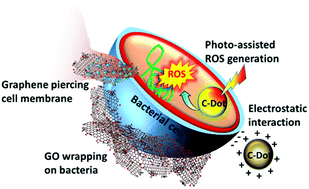当前位置:
X-MOL 学术
›
Nanoscale Horiz.
›
论文详情
Our official English website, www.x-mol.net, welcomes your feedback! (Note: you will need to create a separate account there.)
Graphene oxide and carbon dots as broad-spectrum antimicrobial agents - a minireview.
Nanoscale Horizons ( IF 9.7 ) Pub Date : 2018-09-13 , DOI: 10.1039/c8nh00174j Anisha Anand,Binesh Unnikrishnan,Shih-Chun Wei,C Perry Chou,Li-Zhi Zhang,Chih-Ching Huang
Nanoscale Horizons ( IF 9.7 ) Pub Date : 2018-09-13 , DOI: 10.1039/c8nh00174j Anisha Anand,Binesh Unnikrishnan,Shih-Chun Wei,C Perry Chou,Li-Zhi Zhang,Chih-Ching Huang

|
Due to the increasing global population, growing contamination of water and air, and wide spread of infectious diseases, antibiotics are extensively used as a major antibacterial drug. However, many microbes have developed resistance to antibiotics through mutation over time. As an alternative to antibiotics, antimicrobial nanomaterials have attracted great attention due to their advantageous properties and unique mechanisms of action toward microbes. They inhibit bacterial growth and destroy cells through complex mechanisms, making it difficult for bacteria to develop drug resistance, though some health concerns related to biocompatibility remain for practical applications. Among various antibacterial nanomaterials, carbon-based materials, especially graphene oxide (GO) and carbon dots (C-Dots), are promising candidates due to the ease of production and functionalization, high dispersibility in aqueous media, and promising biocompatibility. The antibacterial properties of these nanomaterials can be easily adjusted by surface modification. They are promising materials for future applications against multidrug-resistant bacteria based on their strong capacity in disruption of microbial membranes. Though many studies have reported excellent antibacterial activity of carbon nanomaterials, their impact on the environment and living organisms is of concern due to the accumulatory and cytotoxic effects. In this review, we discuss antimicrobial applications of the functional carbon nanomaterials (GO and C-Dots), their antibacterial mechanisms, factors affecting antibacterial activity, and concerns regarding cytotoxicity.
中文翻译:

氧化石墨烯和碳点作为广谱抗菌剂-综述。
由于全球人口的增加,水和空气污染的增加以及传染病的广泛传播,抗生素被广泛用作主要的抗菌药物。然而,随着时间的推移,许多微生物通过突变已发展出对抗生素的抗性。作为抗生素的替代品,抗菌纳米材料由于其优越的性能和对微生物的独特作用机理而引起了极大的关注。它们抑制细菌的生长并通过复杂的机制破坏细胞,使细菌难以产生耐药性,尽管与生物相容性有关的一些健康问题仍在实际应用中。在各种抗菌纳米材料中,碳基材料,尤其是氧化石墨烯(GO)和碳点(C-Dots),由于易于生产和功能化,在水性介质中的高分散性以及有希望的生物相容性,它们是有希望的候选物。这些纳米材料的抗菌性能可通过表面改性轻松调节。由于它们具有强大的破坏微生物膜的能力,它们是有前景的材料,可用于未来抗多药耐药细菌的应用。尽管许多研究都报告了碳纳米材料具有出色的抗菌活性,但由于其累积和细胞毒性作用,它们对环境和生物的影响值得关注。在这篇综述中,我们讨论了功能性碳纳米材料(GO和C-Dots)的抗菌应用,它们的抗菌机制,影响抗菌活性的因素以及有关细胞毒性的问题。在水性介质中具有很高的分散性,并有望实现生物相容性。这些纳米材料的抗菌性能可通过表面改性轻松调节。由于它们具有强大的破坏微生物膜的能力,它们是有前景的材料,可用于未来抗多药耐药细菌的应用。尽管许多研究都报告了碳纳米材料具有出色的抗菌活性,但由于其累积和细胞毒性作用,它们对环境和生物的影响值得关注。在这篇综述中,我们讨论了功能性碳纳米材料(GO和C-Dots)的抗菌应用,它们的抗菌机制,影响抗菌活性的因素以及有关细胞毒性的问题。在水性介质中具有很高的分散性,并有望实现生物相容性。这些纳米材料的抗菌性能可通过表面改性轻松调节。由于它们具有强大的破坏微生物膜的能力,它们是有前景的材料,可用于未来抗多药耐药细菌的应用。尽管许多研究都报告了碳纳米材料具有出色的抗菌活性,但由于其累积和细胞毒性作用,它们对环境和生物的影响值得关注。在这篇综述中,我们讨论了功能性碳纳米材料(GO和C-Dots)的抗菌应用,它们的抗菌机制,影响抗菌活性的因素以及有关细胞毒性的问题。这些纳米材料的抗菌性能可通过表面改性轻松调节。由于它们具有强大的破坏微生物膜的能力,它们是有前景的材料,可用于未来抗多药耐药细菌的应用。尽管许多研究都报告了碳纳米材料具有出色的抗菌活性,但由于其累积和细胞毒性作用,它们对环境和生物的影响值得关注。在这篇综述中,我们讨论了功能性碳纳米材料(GO和C-Dots)的抗菌应用,它们的抗菌机制,影响抗菌活性的因素以及有关细胞毒性的问题。这些纳米材料的抗菌性能可通过表面改性轻松调节。由于它们具有强大的破坏微生物膜的能力,它们是有前景的材料,可用于未来抗多药耐药细菌的应用。尽管许多研究都报告了碳纳米材料具有出色的抗菌活性,但由于其累积和细胞毒性作用,它们对环境和生物的影响值得关注。在这篇综述中,我们讨论了功能性碳纳米材料(GO和C-Dots)的抗菌应用,它们的抗菌机制,影响抗菌活性的因素以及有关细胞毒性的问题。由于它们具有强大的破坏微生物膜的能力,它们是有前景的材料,可用于未来抗多药耐药细菌的应用。尽管许多研究都报告了碳纳米材料具有出色的抗菌活性,但由于其累积和细胞毒性作用,它们对环境和生物的影响值得关注。在这篇综述中,我们讨论了功能性碳纳米材料(GO和C-Dots)的抗菌应用,它们的抗菌机制,影响抗菌活性的因素以及有关细胞毒性的问题。由于它们具有强大的破坏微生物膜的能力,它们是有前景的材料,可用于未来抗多药耐药细菌的应用。尽管许多研究都报告了碳纳米材料具有出色的抗菌活性,但由于其累积和细胞毒性作用,它们对环境和生物的影响值得关注。在这篇综述中,我们讨论了功能性碳纳米材料(GO和C-Dots)的抗菌应用,它们的抗菌机制,影响抗菌活性的因素以及有关细胞毒性的问题。
更新日期:2018-09-05
中文翻译:

氧化石墨烯和碳点作为广谱抗菌剂-综述。
由于全球人口的增加,水和空气污染的增加以及传染病的广泛传播,抗生素被广泛用作主要的抗菌药物。然而,随着时间的推移,许多微生物通过突变已发展出对抗生素的抗性。作为抗生素的替代品,抗菌纳米材料由于其优越的性能和对微生物的独特作用机理而引起了极大的关注。它们抑制细菌的生长并通过复杂的机制破坏细胞,使细菌难以产生耐药性,尽管与生物相容性有关的一些健康问题仍在实际应用中。在各种抗菌纳米材料中,碳基材料,尤其是氧化石墨烯(GO)和碳点(C-Dots),由于易于生产和功能化,在水性介质中的高分散性以及有希望的生物相容性,它们是有希望的候选物。这些纳米材料的抗菌性能可通过表面改性轻松调节。由于它们具有强大的破坏微生物膜的能力,它们是有前景的材料,可用于未来抗多药耐药细菌的应用。尽管许多研究都报告了碳纳米材料具有出色的抗菌活性,但由于其累积和细胞毒性作用,它们对环境和生物的影响值得关注。在这篇综述中,我们讨论了功能性碳纳米材料(GO和C-Dots)的抗菌应用,它们的抗菌机制,影响抗菌活性的因素以及有关细胞毒性的问题。在水性介质中具有很高的分散性,并有望实现生物相容性。这些纳米材料的抗菌性能可通过表面改性轻松调节。由于它们具有强大的破坏微生物膜的能力,它们是有前景的材料,可用于未来抗多药耐药细菌的应用。尽管许多研究都报告了碳纳米材料具有出色的抗菌活性,但由于其累积和细胞毒性作用,它们对环境和生物的影响值得关注。在这篇综述中,我们讨论了功能性碳纳米材料(GO和C-Dots)的抗菌应用,它们的抗菌机制,影响抗菌活性的因素以及有关细胞毒性的问题。在水性介质中具有很高的分散性,并有望实现生物相容性。这些纳米材料的抗菌性能可通过表面改性轻松调节。由于它们具有强大的破坏微生物膜的能力,它们是有前景的材料,可用于未来抗多药耐药细菌的应用。尽管许多研究都报告了碳纳米材料具有出色的抗菌活性,但由于其累积和细胞毒性作用,它们对环境和生物的影响值得关注。在这篇综述中,我们讨论了功能性碳纳米材料(GO和C-Dots)的抗菌应用,它们的抗菌机制,影响抗菌活性的因素以及有关细胞毒性的问题。这些纳米材料的抗菌性能可通过表面改性轻松调节。由于它们具有强大的破坏微生物膜的能力,它们是有前景的材料,可用于未来抗多药耐药细菌的应用。尽管许多研究都报告了碳纳米材料具有出色的抗菌活性,但由于其累积和细胞毒性作用,它们对环境和生物的影响值得关注。在这篇综述中,我们讨论了功能性碳纳米材料(GO和C-Dots)的抗菌应用,它们的抗菌机制,影响抗菌活性的因素以及有关细胞毒性的问题。这些纳米材料的抗菌性能可通过表面改性轻松调节。由于它们具有强大的破坏微生物膜的能力,它们是有前景的材料,可用于未来抗多药耐药细菌的应用。尽管许多研究都报告了碳纳米材料具有出色的抗菌活性,但由于其累积和细胞毒性作用,它们对环境和生物的影响值得关注。在这篇综述中,我们讨论了功能性碳纳米材料(GO和C-Dots)的抗菌应用,它们的抗菌机制,影响抗菌活性的因素以及有关细胞毒性的问题。由于它们具有强大的破坏微生物膜的能力,它们是有前景的材料,可用于未来抗多药耐药细菌的应用。尽管许多研究都报告了碳纳米材料具有出色的抗菌活性,但由于其累积和细胞毒性作用,它们对环境和生物的影响值得关注。在这篇综述中,我们讨论了功能性碳纳米材料(GO和C-Dots)的抗菌应用,它们的抗菌机制,影响抗菌活性的因素以及有关细胞毒性的问题。由于它们具有强大的破坏微生物膜的能力,它们是有前景的材料,可用于未来抗多药耐药细菌的应用。尽管许多研究都报告了碳纳米材料具有出色的抗菌活性,但由于其累积和细胞毒性作用,它们对环境和生物的影响值得关注。在这篇综述中,我们讨论了功能性碳纳米材料(GO和C-Dots)的抗菌应用,它们的抗菌机制,影响抗菌活性的因素以及有关细胞毒性的问题。


























 京公网安备 11010802027423号
京公网安备 11010802027423号